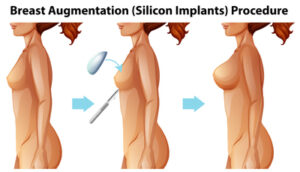Breast implants, often referred to as breast silicone, are one of the most commonly used materials in augmentation procedures. They come in various shapes and compositions, including saline-filled and silicone gel-filled types. Saline implants contain sterile saltwater and are encased in a silicone shell. The amount of fluid can be adjusted to achieve the desired shape and firmness post-surgery.

Types of Breast Aesthetic Procedures
Breast aesthetic surgeries vary depending on the desired outcome. Some of the most common procedures include:
Breast Augmentation
Breast augmentation involves enhancing the size and volume of the breasts. This can be done by inserting implants beneath the breast tissue or chest muscles. In some cases, fat grafting using the patient’s own body fat is utilized. The placement of implants can be either submuscular (beneath the muscle) or subglandular (behind the breast tissue). Patients can choose from various implant shapes and sizes based on their aesthetic goals.
Breast Lift (Mastopexy)
A breast lift is performed to elevate and reshape sagging breasts, often caused by aging, pregnancy, breastfeeding, or significant weight loss. The procedure may include removing excess skin and tightening surrounding tissue. In some cases, a breast implant may be used to restore volume and enhance the lift. The position of the nipple and areola may also be adjusted to achieve a youthful contour.
Post-Pregnancy Breast Lift
Following pregnancy and breastfeeding, many women experience changes in breast firmness and shape. A post-pregnancy breast lift helps restore a firm, perky appearance. This may be combined with implants for additional volume, known as augmentation mastopexy. These procedures do not interfere with breastfeeding ability and are commonly chosen by mothers seeking to regain pre-pregnancy contours.
Breast Reduction
Breast reduction surgery is ideal for individuals with overly large breasts that may cause discomfort such as back pain, neck strain, or skin irritation. The procedure involves removing excess breast fat, glandular tissue, and skin to achieve a breast size in proportion with the body. It also improves physical activity and posture. Breast reduction is frequently selected for both aesthetic and medical reasons.
Breast Contouring and Tightening
This procedure aims to improve the firmness and positioning of the breasts, especially after weight fluctuations, aging, or breastfeeding. It typically involves lifting the breast tissue and may include the use of implants for added fullness. Performed under general anesthesia, breast contouring improves both the function and appearance of the breasts.

How is Breast Aesthetic Surgery Performed?
Breast aesthetic procedures are usually performed under general anesthesia. Before surgery, a detailed consultation is conducted where the surgeon evaluates the patient’s anatomy and discusses their goals. Implant trials may be used to visualize the potential outcome.
Incision techniques vary depending on the procedure type, implant size, and patient anatomy. Common incision sites include:
- Inframammary (beneath the breast fold)
- Transaxillary (through the armpit)
- Periareolar (around the nipple area)
The placement of implants can be:
- Submuscular: Under the pectoral muscle, allowing for a more natural contour.
- Subglandular: Behind the breast tissue, leading to a shorter recovery time.
After the implant is inserted, the incision is closed with sutures. Initial swelling is common and typically resolves within a couple of weeks.
Recovery and Post-Operative Care
Following breast aesthetic surgery, it is normal to experience mild fatigue, swelling, and discomfort. Pain medication, support bras, and elastic bandages may be recommended to aid healing. In some cases, drains are used to remove excess fluids.
Key post-operative care instructions include:
- Proper wound care and hygiene
- Medication adherence
- Monitoring the incision sites
- Avoiding strenuous activities for approximately six weeks
- Attending scheduled follow-up visits
Patients should immediately consult a healthcare provider if they notice signs of infection (fever, redness, or swelling), chest pain, or difficulty breathing.

Breast Reconstruction After Cancer
Breast reconstruction after mastectomy is a common procedure for patients recovering from breast cancer. It helps restore the shape and appearance of the breast using implants or natural tissue flaps. Silicone implants are frequently used for reconstruction due to their natural feel and appearance.
Plastic surgeons specializing in breast reconstruction work closely with oncology teams to create personalized treatment plans. This approach aims to improve both physical and emotional recovery for patients who have undergone cancer treatment.
Breast Aesthetic Surgery Costs
The cost of breast aesthetic procedures varies based on several factors, including:
- Type and quality of implants used
- Experience of the surgeon
- Location and reputation of the clinic
- Complexity of the surgical procedure
Exact pricing can only be determined after a medical consultation and assessment of individual needs.
Why Choose Mode Health Services?
If you are considering a breast aesthetic procedure such as augmentation, lift, reduction, or post-pregnancy correction, Mode Health Services offers expert guidance and personalized care. Our board-certified surgeons are experienced in the latest aesthetic techniques and work with you to achieve natural, satisfying results.




